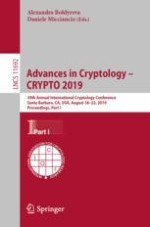2019 | OriginalPaper | Buchkapitel
On the Shortness of Vectors to Be Found by the Ideal-SVP Quantum Algorithm
verfasst von : Léo Ducas, Maxime Plançon, Benjamin Wesolowski
Erschienen in: Advances in Cryptology – CRYPTO 2019
Aktivieren Sie unsere intelligente Suche, um passende Fachinhalte oder Patente zu finden.
Wählen Sie Textabschnitte aus um mit Künstlicher Intelligenz passenden Patente zu finden. powered by
Markieren Sie Textabschnitte, um KI-gestützt weitere passende Inhalte zu finden. powered by
